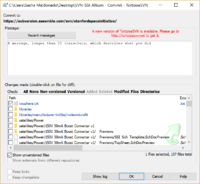SVN
SVN is a version control tool used by SSI to store and synchronize files. SVN is similar to Git, but is better for large non-text files, while Git is better for text and code. SVN is like the grandfather of Google Drive. Despite it's age, SVN is still heavily used in industry and engineering startups. Within SSI, SVN is mainly used for:
- Large graphics files, like and Photoshop, InDesign
- A few CAD and simulation projects
SSI used to store many more things on SVN, namely PCB designs, Solidworks CAD, and Altium Libraries. Over time, these things migrated to their own platforms: GrabCAD, Altium365, and Github.
Background
An SVN repository is a series of "snapshots" of a folder over time. Each snapshot is called a commit, and represents the state of the folder and some or all of its contents at a moment in time. Commits are created by users (aka you) when they want to preserve a version of the files they are working on - this typically happens after making a group of changes to files stored in the SVN repository (ie. after adding a part to a library or making progress on a circuit schematic or circuit board).
Any file can be stored in an SVN repository, and the repository can detect any change to any file. With TortoiseSVN installed, tracked files in an SVN repository which have been edited since the last commit will have a small red exclamation point displayed on their icon when viewed in a folder. New files created in your Altium SVN folder will not automatically be tracked - this is intentional, and a good thing.
Unlike other version control systems, SVN does not have "branches". All commits in an SVN repository contain changes that directly follow the commit before them, and can have only a single commit that follows after them. Because of this, SVN users can lock files and folders, becoming the only person allowed to commit changes to that file or folder. Other users can still edit the files, but their changes cannot be committed, making those edits futile. TortoiseSVN shows when a file has been locked by someone else, to help keep you from trying to edit something that somebody else is working on. Locking exists so that two users cannot try to commit different versions of the same file - someone who opens a file and knows they will commit changes to it soon can lock the file, marking the fact that they started editing the file first and so should be allowed to complete and commit their changes before anyone else. Locks can be taken away from someone who locks a file for an extended period of time, preventing abuse of this feature.
Changes other people make to files stored in the SVN must be downloaded manually, through the SVN update command. Updating replaces any files in your SVN folder that have been changed since the last time you ran SVN update with their most recently committed versions.
Your First Commit
In your SSI Altium SVN folder, right click while not on any file or folder, and mouse down to "SVN Update" and click it. This will quickly bring all of your files up to date. Next, in your Altium SVN folder, find "iwuzhere.txt." This file is tracked by the SVN repository, and should have a small green check mark on it. Right click on the file, mouse down to "TortoiseSVN," and then click "Get lock..." Click OK on any windows that appear. A small lock icon should appear on the file - you now have the lock on this file.
If the file was already locked by someone else, you will not be able to lock it, and should message the ![]() #altium
#altium
Open the file, and add your name and the current date, matching the format of the names already there. You're now a part of SSI's corps of electrical engineers!
To finish, go back to your Altium SVN folder, right click while not on any file or folder, and mouse down to "SVN Commit..." and click it. A dialog box will come up (see right), at the bottom of which should be a list of files. This shows files you have changed since the last time you ran SVN update, and should just have iwuzhere.txt listed. Make sure you have it checked. In the text box at the top of the window, you will need to write a commit message, a brief description of what changes you're committing. This message will appear in Slack and must be at least 20 characters (but shouldn't be longer than a single sentence). Once you've written it, click okay, and wait for a message to appear in Slack.
